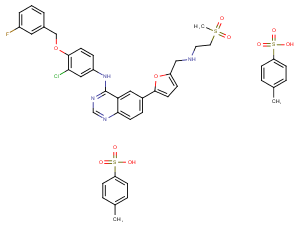Powder: -20°C for 3 years | In solvent: -80°C for 1 year


Lapatinib Ditosylate (Tykerb ditosylate) is an effective EGFR and ErbB2 inhibitor (IC50: 10.8/9.2 nM for EGFR/ErbB2).

| Pack Size | Availability | Price/USD | Quantity |
|---|---|---|---|
| 25 mg | In stock | $ 39.00 | |
| 50 mg | In stock | $ 53.00 | |
| 100 mg | In stock | $ 67.00 | |
| 200 mg | In stock | $ 87.00 | |
| 500 mg | In stock | $ 130.00 | |
| 1 g | In stock | $ 150.00 | |
| 1 mL * 10 mM (in DMSO) | In stock | $ 57.00 |


| Description | Lapatinib Ditosylate (Tykerb ditosylate) is an effective EGFR and ErbB2 inhibitor (IC50: 10.8/9.2 nM for EGFR/ErbB2). |
| Targets&IC50 | ErbB2:9.2 nM (cell free), EGFR:10.8 nM (cell free) |
| In vitro | Lapatinib (1 μM) induces apoptosis in NCI-N87 and OD19 cells [2]. Lapatinib inhibits the growth of EGFR-overexpressing A431 skin cancer (IC50: 0.14 μM) and ErbB2-overexpressing SK-BR-3 breast cancer cells (IC50: 0.124 μM). It also inhibits the growth of ErbB2-amplified OD19 esophageal (IC50: 0.09 μM)and NCI-N87 gastric cancer cells (IC50: 0.01 μM) as well as several types of gastric cancer cells in which ErbB2 is not amplified (IC50s: 0.35-8.58 μM) [3] . |
| In vivo | Lapatinib ( 30 and 100 mg/kg, p.o., b.i.d) dose-responsive inhibited the growth of BT474 and HN5 human tumor xenografts. Complete inhibition of tumor growth is seen at the 100 mg/kg dose. At this dose, there is <10% weight loss in treated animals over the course of the 21-day treatment. Lapatinib treatment inhibits tumor xenograft growth of the HN5 and BT474 cells in a dose-responsive manner at 30 and 100 mg/kg orally, twice daily, with complete inhibition of tumor growth at the higher dose [1]. Lapatinib (100 mg/kg/day, p.o.) induces severe oxidative damage in the cardiac tissue of rat [4]. |
| Kinase Assay | The IC50 values for inhibition of enzyme activity are generated by measuring the inhibition of phosphorylation of a peptide substrate. The intracellular kinase domains of EGFR and ErbB2 are purified from a baculovirus expression system. EGFR and ErbB2 reactions are performed in 96-well polystyrene round-bottomed plates in a final volume of 45 μL. Reaction mixtures contain 50 mM 4-morpholinepropanesulfonic acid (pH 7.5), 2 mM MnCl2, 10 μM ATP, 1 μCi of [γ33P] ATP/reaction, 50 μM Peptide A [Biotin-(amino hexonoic acid)-EEEEYFELVAKKK-CONH2], 1 mM dithiothreitol, and 1 μL of DMSO containing serial dilutions of Lapatinib beginning at 10 μM. The reaction is initiated by adding the indicated purified type-1 receptor intracellular domain. The amount of enzyme added is 1 pmol/reaction (20 nM). Reactions are terminated after 10 minutes at 23°C by adding 45 μL of 0.5% phosphoric acid in water. The terminated reaction mix (75 μL) is transferred to phosphocellulose filter plates. The plates are filtered and washed three times with 200 μL of 0.5% phosphoric acid. Scintillation cocktail (50 μL) is added to each well, and the assay is quantified by counting in a Packard Topcount. IC50 values are generated from 10-point dose-response curves [1]. |
| Cell Research | Cells are plated in 96-well plates, in the media, at the following densities: HFF and HN5, 1000 cells/well and BT474, 5000 cells/well. After 24 h, the cells are exposed to vehicle (0.3% DMSO) or Lapatinib (1 nM, 10 nM, 100 nM, 1μM, 10μM, and 100μM). Lapatinib is removed from the cells after 72 h and is replaced by either DMEM containing 10% FBS and 50 μg/mL Gentamicin (HFF and HN5) or RPMI containing 10% FBS and 50 μg/mL Gentamicin (BT474). Methylene blue staining is performed at the time points over a total period of 16 days. Relative cell number is estimated using methylene blue staining. The absorbance at 620 nm is read in a Spectra microplate reader. Cell death and cell cycle analysis are assessed by propidium iodide staining and antibody detection of incorporated BrdUrd and staining with propidium iodide [1]. |
| Animal Research | CD-1 nude female mice are used for HN5 human tumor xenografts, which are initiated by injection of a cell suspension in PBS: Matrigel (1:1). C.B-17 SCID female mice are used for BT474 human tumor xenografts, which are initiated by implantation of tumor fragments (20-100 mg) from established tumors. Tumor cells and fragments are implanted by s.c. injection in the right flank. The s.c. tumors are measured with calipers, and mice are weighed twice weekly. Tumor weight is estimated from tumor volume using this formula: length×width2/2=tumor volume (mm3). Treatment begins when tumors are palpable, 3-5 mm in diameter. Lapatinib (30 and 100 mg/kg) is administered p.o. twice daily for 21 days in a vehicle of sulfo-butyl-ether-β-cyclodextrin 10% aqueous solution (CD10) [1]. |
| Synonyms | Lapatinib (GW-572016) Ditosylate, GW-572016 ditosylate, Tykerb ditosylate |
| Molecular Weight | 925.46 |
| Formula | C29H26ClFN4O4S·2C7H8O3S |
| CAS No. | 388082-77-7 |
Powder: -20°C for 3 years | In solvent: -80°C for 1 year
Ethanol: < 1 mg/mL (insoluble or slightly soluble)
DMSO: 93 mg/mL (100.5 mM)
H2O: < 1 mg/mL (insoluble or slightly soluble)
You can also refer to dose conversion for different animals. More
bottom
Please see Inhibitor Handling Instructions for more frequently ask questions. Topics include: how to prepare stock solutions, how to store products, and cautions on cell-based assays & animal experiments, etc.
Lapatinib Ditosylate 388082-77-7 Angiogenesis Apoptosis Autophagy JAK/STAT signaling Tyrosine Kinase/Adaptors Ferroptosis EGFR Inhibitor Lapatinib (GW-572016) Lapatinib (GW-572016) Ditosylate GW2016 ditosylate GW572016 ditosylate GW 572016 GW-572016 ErbB-1 inhibit HER1 Tykerb GW-572016 Ditosylate GW 572016 Ditosylate Epidermal growth factor receptor GW572016 Tykerb Ditosylate GW-572016 ditosylate Lapatinib GW572016 Ditosylate Tykerb ditosylate inhibitor
